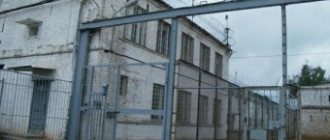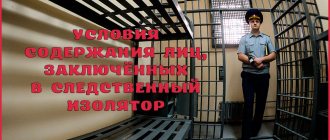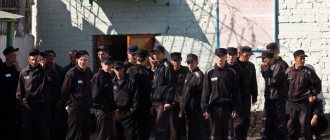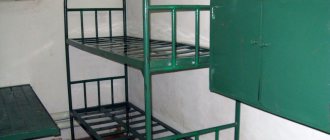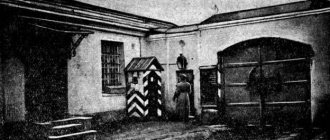How many prisons are there in Russia and what kind of regimes are there?
Currently, according to the Federal Penitentiary Service, there are 35 women’s correctional colonies in Russia. About 60,000 women and girls are serving their sentences in these institutions, which is 5% of the total number of prisoners in Russia. About thirteen thousand of them are minors (read more about how life is for inmates of female juvenile colonies here).
In a general regime colony, convicts serve time for serious criminal acts committed for the first time, as well as for crimes of minor and medium gravity, if the judicial authority considers that the correction of such persons is impossible in a settlement. A strict regime is applied only to repeat offenders and especially cruel murderers.
In addition to correctional colonies, there are institutions such as pre-trial detention centers, in which convicts are under investigation and awaiting further distribution. There are three women's pre-trial detention centers in Russia (Moscow, St. Petersburg, Yekaterinburg).
Read more about the main differences between a maximum security colony and a general colony and others here, and learn about how they live in a maximum security colony, what it is and why it’s better not to go there, in this material.
How women are kept in correctional facilities
It is generally accepted that it is more difficult for women to endure the hardships of imprisonment, therefore the legislator provides more humane conditions for the weaker sex . First of all, this is expressed in the fact that the law does not provide for women’s colonies with strict or special regimes .
Women serve their sentences exclusively in penal colonies and general regime camps , but this is where the relief ends.
The rest of the conditions in prison are no different from those for men. For example, under a strict regime of confinement , a woman is also in a locked room for several dozen people, has the right to stay in the fresh air for no more than one and a half hours a day, meet with relatives and children no more than 2 times a year and receive no more than 3 parcels.
Women, like men, are placed in dormitories or cells. Criminals who have committed a crime for the first time are kept separately from repeat offenders, and criminals who have committed particularly serious offenses are also kept separately from everyone else.
Reference. A privilege can be considered the living space, which is almost doubled compared to men's. Men are allocated 2 square meters. m., women – 3.5 sq.m.
The most stringent correctional MLS
Moscow pre-trial detention center No. 6 is considered one of the most brutal prisons. The prisoners themselves call it nothing more than “SIZO 666”, since the conditions of detention can be called hellish.
Attention! More stringent conditions are observed in colonies where women who have committed repeated and serious crimes are sent, i.e. repeat offenders.
Lack of sleeping places, overcrowded cells and unsanitary conditions. Diseases such as tuberculosis and syphilis flourish as a result of the lack of medical care and basic living conditions. A completely healthy, and sometimes innocent, person emerges sick and exhausted a few months later. Activists and human rights defenders are sounding the alarm, however, to no avail.
Correctional colonies in Mordovia are often mentioned as places where it is better not to go. These institutions are classified as high security detention centers. Their conditions are much worse compared to other similar places of detention. The arbitrariness of the authorities, dirt and meager food are just a few of the things that those serving sentences on the territory of these institutions will have to face.
- IK-13 and IK-14, located in the village of Partsa.
- IK-2 in the village of Java.
Pre-trial detention center for women - what is it?
A pre-trial detention center stands for a pre-trial detention center in which there are persons under investigation, namely, those people whose criminal case is under investigation or legal proceedings and who are awaiting further distribution to a correctional institution or colony.
All other institutions of this type in Russia are mixed, where both men and women serve their sentences. Unlike some men’s detention centers, where certain “concepts” may apply in everyday life, for women everything is simpler and relatively freer. The main attention is paid to everyday life and the distribution of responsibilities between cellmates.
Correctional colonies: living conditions
Most cells are designed for 40-60 people, the beds are installed in two rows , the prisoners themselves call them “bunks”. The cell has a kitchen, where women cook themselves using products purchased from a local store or those sent by relatives, as well as a toilet and shower. Once a week – bath.
Reference. According to prisoners, one of the main inconveniences is the lack of privacy, since most intimate procedures are carried out in full view of their fellow inmates.
Cleaning in the barracks is carried out three times a day, the schedule is set by the senior. Missing duty is unacceptable and is punishable by additional cleaning days. The right to skip duty can be purchased for a pack of cigarettes, food or money.
According to the rules, each convicted person must be given a set of clothes and underwear for a period of one year. Often this rule is not followed. Half of the things are missing, or even issued less than once a year. Prisoners do not have the opportunity to dress warmly in the winter, which leads to an increase in the number of colds. Those who are unable to receive parcels from home have to exchange clothes from fellow inmates or wear cast-offs.
Schedule
A prisoner's standard schedule includes items such as:
- climb;
- toilet;
- Three meals a day;
- working hours with a lunch break;
- personal time from 30 minutes to 1 hour;
- continuous 8-hour sleep.
The day begins with getting up at 6 am, making beds, hygiene procedures and formation for roll call. The prisoners have breakfast and the working day begins, with a break for lunch, until 7-8 pm. After dinner - free time, which is spent at your own discretion: reading, letters home, handicrafts, etc.
Nutrition
The calorie content of the daily diet is approximately 2600–3000 kcal. Dairy, meat, vegetable dishes, as well as hot dishes are required. Prisoners purchase sugar, confectionery, fruits, and semi-finished products on their own, according to the permitted list.
Read more about food in prisons here.
Work and leisure
The working day is 12 hours or on a two-to-one schedule.
The main task is to meet production standards. Reference. Women carry out activities such as cutting and sewing, making workwear, working in a bakery, washing dishes, cleaning, cooking, and working in local art workshops and libraries.
In the absence of the necessary skills, convicts have the opportunity to obtain a profession or retraining in order to subsequently work in the acquired specialty. Training is carried out according to a separate schedule and is compiled individually.
Many correctional institutions have amateur clubs, libraries and study groups organized by the prisoners themselves. Women organize competitions, organize exhibitions, stage plays, hold holidays and even beauty contests.
Religion and Worship
According to the Penal Code of the Russian Federation, Article 14 “Ensuring freedom of conscience and freedom of religion of convicts,” prisoners have the right to profess any religion , as well as to conduct the necessary rituals both in the territory of detention and in specially designated territories, if any.
According to the convicts, faith and religion are what give them the strength to endure their sentences and with dignity endure all the hardships and difficulties associated with prison life. It helps to sincerely repent and enter a new life not as a broken person, but as a full-fledged person with new goals and hope for the future.
Prisons often build their own churches for prisoners to visit during their free time. The convicted person can confess or receive communion, and in case of serious illness the prison provides a priest.
Dates and visits
The types of visits with convicted persons, as well as their number, are determined by the Criminal Executive Code of the Russian Federation (Article 89) - a convicted person has the right to two types of visits within the framework of the rules of a particular correctional institution:
- short-term, which last 4 hours;
- up to three days with accommodation on the territory of the correctional institution;
- in a general regime penal colony it is permissible to have 6 short-term and 4 long-term visits;
- in a strict regime penal colony, 2 short-term and 2 long-term visits are allowed.
The head of the correctional institution independently determines the procedure and place of the meeting.
Read more about the nuances of long-term and short-term visits in maximum security colonies here.
Transfer of things and products
The transfer of things and products is carried out as usual, like all other institutions of this type. List of items allowed for transfer:
- socks, T-shirts and underwear;
- towel and bed linen;
- sports suit;
- sneakers, shower slippers, boots, galoshes;
- personal hygiene items: napkins, toilet paper, sanitary pads, combs, toothbrush;
- unbreakable dishes (plastic, aluminum);
- writing paper;
- a set of pens, with a blue and black core;
- personal photographs (no more than three);
- objects of religious worship (cross, icon, Bible, Koran);
- sweater;
- jacket.
Products:
- canned food and semi-finished products;
- instant noodles, crackers, chips;
- honey and condensed milk in soft packaging;
- confectionery: sweets, cookies, gingerbreads, chocolate (up to 2 kg);
- vegetables and fruits, except citrus fruits (oranges, lemons, grapefruit, pamelo);
- Tea coffee.
Motherhood
Perhaps one of the most difficult and painful topics regarding a woman’s stay in prison. Motherhood is the main purpose and meaning of every woman’s life, and the pregnancy period is one of the most difficult and responsible. Medical care in prison is often unable to provide the expectant mother with the necessary medications, and poor nutrition and hard work only worsen the situation.
Important! Doctors do not bother to examine expectant mothers, who may not be under medical supervision during the entire period, as a result of which a woman is not always able to carry a child to term, not to mention the fact that the baby is born healthy and full-fledged...
Most often, immediately after birth, the newborn is sent to the children's department of the hospital where he undergoes a medical examination, after which he is sent to a baby home.
Not every colony provides the opportunity for a mother to be with her child up to three years of age. Currently, there are 10 colonies with an orphanage in the Russian Federation. Children in such institutions are under the supervision of teachers and provided for at state expense until the age of three, after which they are sent to an orphanage or to the relatives of the prisoner. During the period of placement of a child, the mother is granted leave of 15 days excluding travel. In the future, annual leave for visiting the child is granted for the same period.
"White Swan"
In Solikamsk there is a maximum security correctional colony “White Swan”. There are monuments to these birds in the yard. There are 300 criminals serving their sentences in prison. The cell is designed for 1-3 people, who are placed together based on a psychological profile in order to avoid conflicts. Those criminals serving life sentences are not allowed to work or study in absentia at universities.
Photo: https://kaspyinfo.ru/
CCTV cameras are installed on the territory of the colony, and the site, in addition to people, is guarded by 50 dogs. The prison provides itself with meat, vegetables and fruits. There is a furniture production workshop on the territory of the colony. Among the prisoners: Dmitry Vinogradov - a murderer of 6 people, Oleg Datsko - a member of an organized crime group, Adam Tsurov - a terrorist.
Release on parole
Conditional early release can be applied only after the convicted person has actually served:
- at least one third of the sentence imposed for a crime of minor or medium gravity;
- not less than half of the sentence imposed for a serious crime;
- at least two-thirds of the sentence imposed for a particularly serious crime.
How to get it and what does the court pay attention to?
- behavior of the convicted person in the colony, compliance with the regime and internal regulations;
- degree of repentance, admission of guilt and willingness to bear responsibility for the offense committed (compensation for moral and material damage to the victim);
- sincerity in repentance and willingness to change one’s life, learn a new profession, and be useful to society;
- whether the convicted person has received incentives or penalties from the prison administration;
- presence of an official place of work and attitude towards work in general;
- participation of the convicted person in the life of the team, work and leisure activities during the process of serving the term;
- availability of permanent residence or plans to acquire it;
- willingness to become a good citizen, benefit society and work.
Attention! It is worth noting that the court will evaluate the totality of the circumstances. Lack of place of residence or work, in the presence of other positive factors, will not become an obstacle to satisfying parole.
Hierarchy in cells
Relations between prisoners are, as a rule, neutral. This is not a men's prison, where there is a struggle for leadership; the concept of “lowered” does not come up often. The exceptions are child killers - they, as a rule, are hated in women's prisons and can be humiliated or even beaten.
The hierarchy in the women's cell is like a beehive and, in fact, resembles a large family, with its own nuances, of course. There is a “womb” - the eldest, her assistants, to whom the eldest delegates her unspoken responsibilities, and the rest of the women.
The assistants monitor cleanliness, draw up a duty schedule, monitor food intake, and inspect the cell for items that are not allowed. Women's unions are often formed in prison, a so-called “family” in which they communicate, they can share food, clothing, cosmetics, but these relationships cannot be called bosom friendship, although the cases are different. Sometimes former cellmates remain friends even after release.
"Polar Owl"
The colony was built in the Yamalo-Nenets Autonomous Okrug. The Polar Owl is home to 330 criminals, some of whom have killed hundreds of people. The buildings are old and in disrepair. The prison conditions are as bad as the weather. In winter, the air temperature stays at –40. Only one month of the year is summer - July. The Polar Owl houses murderers, state criminals, extremists and repeat offenders.
After the trial of FSIN Lieutenant Colonel Yuri Sandrykin, it became known that prisoners were beaten and abused. Comfortable cells are equipped for “exemplary” criminals. Prisoners are not taken outside; they walk in a square room without a ceiling, but with bars. Alexander Pichushkin, the “Bitsevsky maniac” who killed 48 people, lives in such conditions; Dmitry Voronenko - “Petersburg Maniac”, with 4 lives to his name; Denis Evsyukov is a former policeman who shot people in a store; Nurpasha Kulaev - Beslan terrorist.


